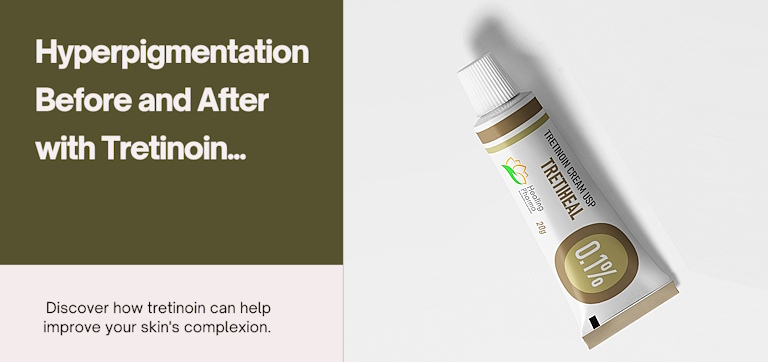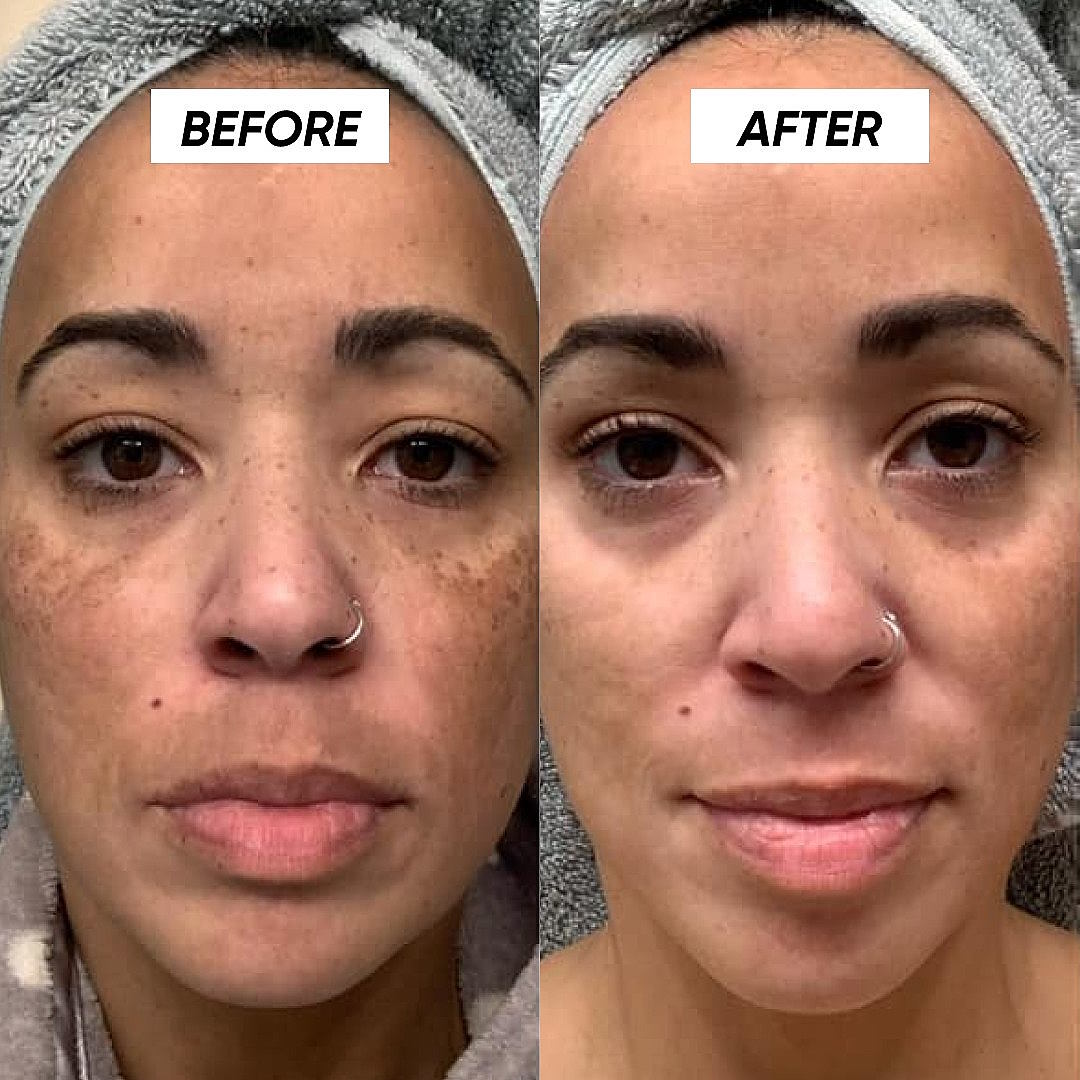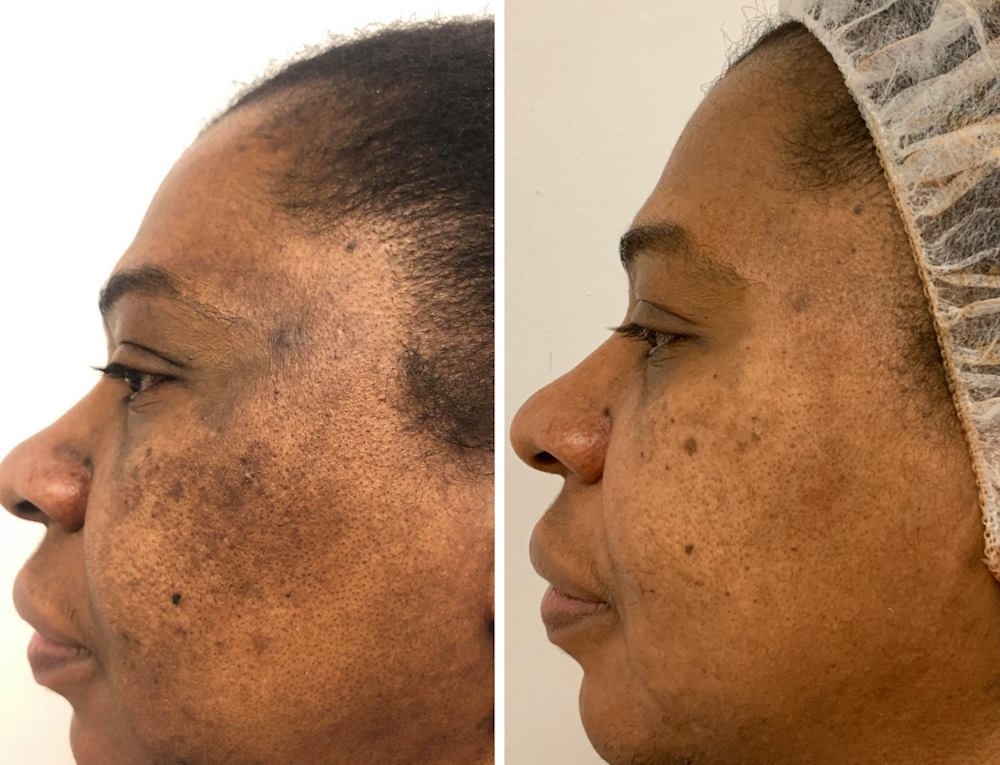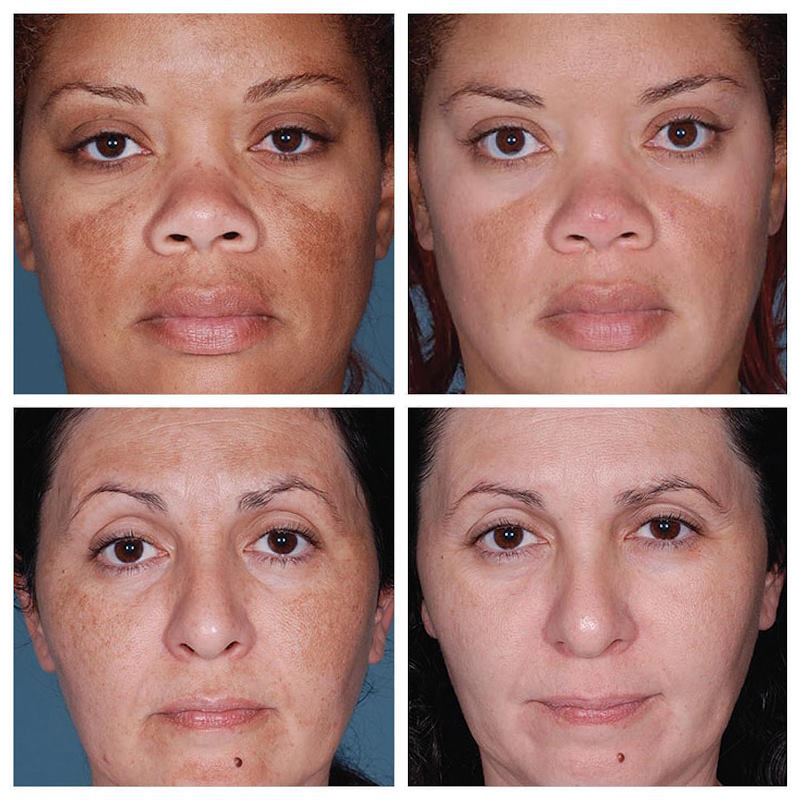Witness the Transformation: Hyperpigmentation Tretinoin Before & After
Table of Contents
Hyperpigmentation is a very common skin issue these days that many people grapple with, seeking effective solutions to gain an even and clearer complexion. Even though there are numerous remedies available in the market, Tretinoin stands out as a formidable contender in the treatment category for hyperpigmentation-associated skin conditions and more.
In this article we are going to comprehensively review the position of tretinoin within the treatment of hyperpigmentation, covering its mechanisms of action, efficacy, potential side effects, and real-world data from clinical cases.
So, let’s delve into the journey of transformation via the lens of hyperpigmentation before and after Tretinoin treatment.
What causes Hyperpigmentation?
Hyperpigmentation can arise from a wide variety of factors such as genetical, environmental, and acquired causes. However, in general, sun exposure, hormonal fluctuations, inflammation, and skin trauma are the most common ones in many cases.
Sun Exposure
Excessive exposure to ultraviolet (UV) radiation from the sun is one of the primary causes for the exacerbations in skin hyperpigmentation as it stimulates melanocytes, ultimately leading to increased melanin production and subsequent darkening of the skin.
Hormonal Changes
Hormonal fluctuations that occur particularly during pregnancy and while taking hormonal contraceptives like oral pills, transdermal patches, vaginal rings, and IUCDs can act as a trigger for the development or the exacerbation of hyperpigmentation, commonly known as melasma or chloasma.
Inflammation
Common skin conditions associated with inflammatory reactions such as acne, psoriasis, and eczema can cause post-inflammatory hyperpigmentation, where sites of healed blemishes or injuries develop into dark spots or patches over time.
Skin Injuries
Injuries to the skin, including cuts, burns, and abrasions, can trigger the skin’s natural defense mechanism, resulting in the overproduction of melanin in the injury site leading to the formation of dark scars or spots.
-
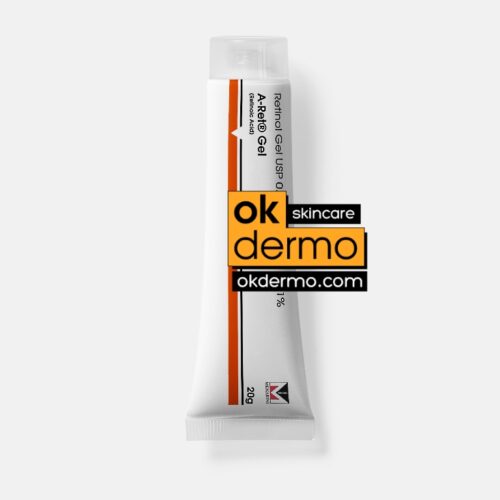
A-Ret® Tretinoin Retinoid Skin Gel
Tretinoin 0.025% / 0.05% / 0.1% USP
Size: 20g / 0.7oz
Brand name: Retin-A Gel, Atralin, Renova, Avita
From USD $25.00 Select options -
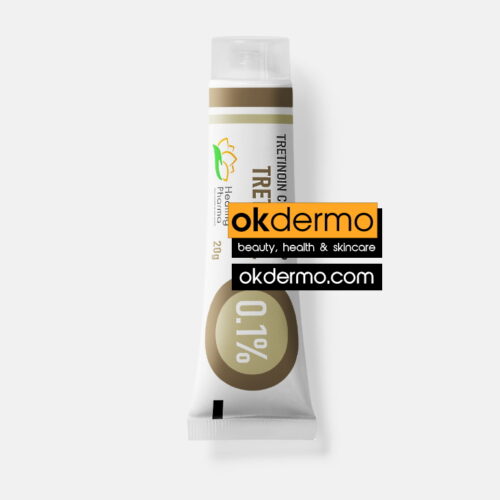
Retin-A® Tretinoin Topical Cream
Tretinoin Cream USP 0.025% / 0.05% / 0.1%
Size: 20g / 0.7oz, 30g / 1.05oz
Brand name: Retin-A, Vitacid, Renova, Avita, Refissa, Atralin, Tretin-X, Rejuva-A, Stieva-A, Tretinoïne, Retacnyl
From USD $26.00 Select options -
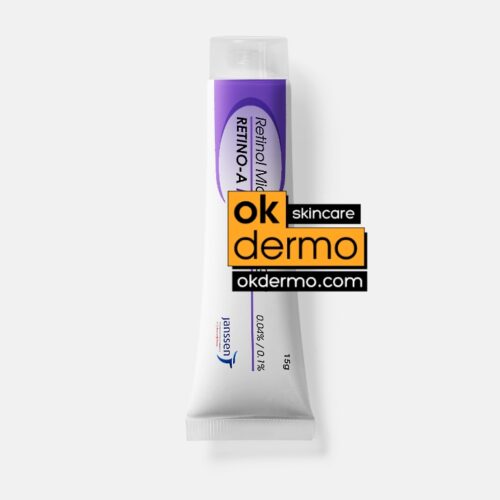
Retin-A Micro® Tretinoin Gel Micronized
Tretinoin Microspheres™ 0.04% / 0.1%
Size: 15g / 0.53oz
Brand name: Retin-A Micro Gel, Atralin, Renova, Avita, Supatret, Signatret, Trunex
From USD $25.00 Select options
Types of Hyperpigmentation
Hyperpigmentation clinically manifests in various forms, with unique characteristics and underlying causes.
Melasma
Melasma presents as symmetrical patches of dark pigmentation, typically on the face, and is commonly associated with hormonal changes that can occur during pregnancy, or with usage of hormonal contraceptive methods such as oral pills.
Post-inflammatory Hyperpigmentation (PIH)
As we discussed earlier, PIH occurs as a result of inflammation or injury to the skin and is characterized by dark spots/ patches that develop at the site of healed acne, eczema or psoriasis lesions, and cuts, or other wounds.
Sun Spots
Also known as solar lentigines or liver spots, sun spots are flat, brown spots that develop on sun-exposed areas of the skin, such as the face, hands, and arms due to cumulative sun damage over time.
Age Spots
Age spots also referred to as senile lentigines, are similar to sunspots but typically emerge later in life as a combined effect of natural aging and prolonged UV exposure.
What is Tretinoin?
Tretinoin, a form of retinoic acid, belongs to a class of medications known as retinoids. It increases cell turnover and promotes the shedding of dead skin cells in the epithelium, which helps to unclog pores, fade dark spots, and stimulate collagen production to address a wide spectrum of skin concerns.
The Science Behind Tretinoin for Hyperpigmentation
Tretinoin exerts its effects on hyperpigmentation through several mechanisms, including inhibition of melanin synthesis, promotion of epidermal turnover, and modulation of cellular differentiation.
- Promotion of Epidermal Turnover: Tretinoin promotes the shedding of melanin-containing keratinocytes from the epidermis, thereby accelerating the turnover of skin cells. This helps to remove hyperpigmented cells from the skin’s surface, leading to a more even complexion over time.
- Inhibition of Melanogenesis: Tretinoin interferes with the production of melanin, the pigment responsible for skin coloration. It does so by downregulating the activity of tyrosinase, the enzyme involved in melanin synthesis, and by inhibiting melanosome transfer to surrounding keratinocytes.
- Stimulation of Collagen Synthesis: Tretinoin also stimulates collagen production in the dermis, which can improve skin texture and further contribute to a more uniform appearance.
By targeting these pathways, tretinoin helps to reduce hyperpigmentation and improve overall skin tone.
Application Methods
Tretinoin is available in various formulations, including creams, gels, and solutions, each with its own unique properties and considerations for application.
Frequency of Use
The frequency of tretinoin application depends on your skin’s tolerance and the severity of your hyperpigmentation. It is typically applied once daily in the evening, as sunlight can deactivate the medication and increase the risk of irritation.
Potential Side Effects
Common side effects of tretinoin include redness, peeling, dryness, and increased sensitivity to sunlight. These side effects are usually mild and temporary, but they can be managed with proper skin care and gradual introduction of the medication.
Before starting tretinoin for Hyperpigmentation
Before using tretinoin for hyperpigmentation, it’s essential to consult with a dermatologist who can assess your skin type and recommend the appropriate strength and formulation of tretinoin for your specific needs.
Tretinoin can cause skin irritation, so it’s crucial to follow your dermatologist’s instructions carefully and start with a lower concentration if necessary.
Indications for the use
- Acne Vulgaris: Tretinoin is indicated for the treatment of non-inflammatory and inflammatory acne vulgaris. It helps to unclog pores and reduce the formation of new acne lesions.
- Photoaging: Tretinoin is also indicated for the treatment of photodamaged skin, including fine wrinkles, mottled hyperpigmentation, and rough skin texture.
Contraindications
- Hypersensitivity: Patients with a known hypersensitivity to tretinoin or any of its components should not use this medication.
- Pregnancy: Tretinoin is contraindicated in pregnancy due to its potential to cause fetal harm. It is classified as a Pregnancy Category C drug.
- Photosensitivity: Tretinoin may increase sensitivity to sunlight, so patients should be advised to use sunscreen and avoid excessive sun exposure during treatment.
Before starting tretinoin, it’s a good idea to take photographs of the areas with hyperpigmentation to track your progress over time. This will help you better assess the effectiveness of the treatment.
After consistent use of tretinoin, you may observe a reduction in the intensity of hyperpigmentation, and the overall tone and texture of your skin may improve.
Additionally, tretinoin can also help prevent future hyperpigmentation by promoting healthier skin turnover and minimizing the appearance of dark spots.
Tretinoin Cream Before and After: What to Expect
The timeline for seeing results with tretinoin can vary from person to person, but noticeable improvements in hyperpigmentation typically occur within several weeks to months of consistent use.
Initial Reactions
In the initial stages of tretinoin treatment, you may experience an increase in skin dryness, flakiness, and irritation as your skin adjusts to the medication. This is commonly referred to as the “retinization” period and is a normal part of the process.
Gradual Improvement
Over time, as your skin becomes acclimated to tretinoin, you can expect to see a gradual fading of dark spots and an overall improvement in skin tone and texture. However, patience is key, as achieving optimal results may require several months of continued use.
Evidence from Clinical Studies
Clinical studies have demonstrated the efficacy of tretinoin in improving various forms of hyperpigmentation, including melasma, solar lentigines, and PIH.
A randomized, double-blind study involving 48 people followed for 40 weeks demonstrated a significant reduction in melanin content and improvement in skin texture following tretinoin treatment
Similarly, a clinical review indicated that topical retinoids have been shown to reduce hyperpigmentation in patients with skin of color
Clinical Cases
Case 1: A 35-year-old female presents with melasma on her cheeks and forehead. She has prescribed tretinoin 0.025% cream to be applied nightly. After 12 weeks of treatment, she notices a visible reduction in the intensity of her pigmented lesions and an overall improvement in skin texture.
Case 2: A 45-year-old male with a history of acne-related PIH seeks treatment for persistent hyperpigmented scars on his face. He is started on tretinoin 0.05% gel applied once daily. Despite initial improvement after 8 weeks, he continues treatment for an additional 4 weeks to achieve further fading of his pigmented lesions.
Combining Tretinoin with Other Treatments
Sun Protection
Sun protection is essential when using tretinoin, as it can increase the skin’s sensitivity to UV radiation and exacerbate hyperpigmentation. Daily use of sunscreen with broad-spectrum SPF is recommended to prevent further sun damage and maintain the results of tretinoin treatment.
Hydroquinone
Hydroquinone, a skin-lightening agent, is often combined with tretinoin to enhance its efficacy in fading stubborn dark spots and achieving more uniform skin tone. However, long-term use of hydroquinone should be supervised by a healthcare professional to avoid adverse effects.
Chemical Peels
Chemical peels containing ingredients such as glycolic acid, salicylic acid, or trichloroacetic acid can complement tretinoin treatment by exfoliating the skin, accelerating cellular turnover, and enhancing the penetration of the medication for deeper pigment removal.
Laser Therapy
Laser treatments, such as intense pulsed light (IPL) therapy or fractional laser resurfacing, can target hyperpigmentation at a deeper level, effectively breaking up excess melanin deposits and stimulating collagen production for smoother, clearer skin.
Conclusion
In conclusion, these before and after effects of Hyperpigmentation Tretinoin highlight not only its potency but also its multifaceted approach in tackling various forms of skin discoloration.
Moreover, the combination of clinical evidence, case studies, and practical considerations underscores the importance of consulting dermatologists for personalized treatment plans tailored to individual needs.
By incorporating proper application methods, managing potential side effects, and complementing Tretinoin with adjunctive therapies like sun protection, hydroquinone, chemical peels, or laser treatments, individuals can maximize the transformative effects of Tretinoin on hyperpigmentation.
FAQs
-
How long does tretinoin take to fade hyperpigmentation?
Tretinoin can take several weeks to months to visibly fade hyperpigmentation. Results vary depending on individual skin type and the severity of the pigmentation.
-
Can tretinoin cure hyperpigmentation?
Tretinoin can effectively treat hyperpigmentation by promoting skin cell turnover and reducing melanin production. However, complete “cure” may not be achievable for all cases.
-
Does tretinoin make skin lighter?
Tretinoin can improve skin tone and texture, which may result in a brighter complexion. However, its primary purpose is not to lighten the skin but to treat acne, wrinkles, and hyperpigmentation.
-
Does skin get darker with tretinoin?
Initially, some individuals may experience transient darkening or irritation as the skin adjusts to tretinoin. However, with consistent use, tretinoin can help fade hyperpigmentation and even out skin tone.
-
Does skin look worse after starting tretinoin?
It’s common for the skin to experience a “purge” period after starting tretinoin, characterized by increased acne or irritation. This usually subsides after a few weeks as the skin adjusts to the medication.
-
How do you know if tretinoin is working?
Signs that tretinoin is working include reduced acne, smoother texture, and a more even skin tone over time. Improvement may be gradual, so patience and consistent use are key.
-
Does skin go back to normal after tretinoin?
If you discontinue tretinoin, your skin will gradually return to its pre-treatment state. However, the benefits gained from tretinoin, such as improved texture and reduced acne, may diminish over time without continued use.
References
- Lee AY. Strategies to Enhance the Efficacy of Topical Therapies in Melasma. J Cutan Aesthet Surg. 2013;6(1):6-11.
- Sarkar R, Arora P, Garg VK, Sonthalia S, Gokhale N. Melasma update. Indian Dermatol Online J. 2014;5(4):426-435.
- Grimes PE. Melasma. Etiologic and therapeutic considerations. Arch Dermatol. 1995;131(12):1453-1457.
- Kligman AM, Willis I. A new formula for depigmenting human skin. Arch Dermatol. 1975;111(1):40-48.
- Taylor SC, Torok H, Jones T, Lowe N, Rich P, Tschen E. Efficacy and safety of a new triple-combination agent for the treatment of facial melasma. Cutis. 2003;72(1):67-72.
Post by:
Marcella Jiovanni
Skin Care Professional
“Marcella Jiovanni actively promotes the importance of maintaining healthy skin, she envisions the future of dermatology as moving away from pure medical, pharmacological dermatology and flowing more toward a holistic approach to wellness and skincare.”

